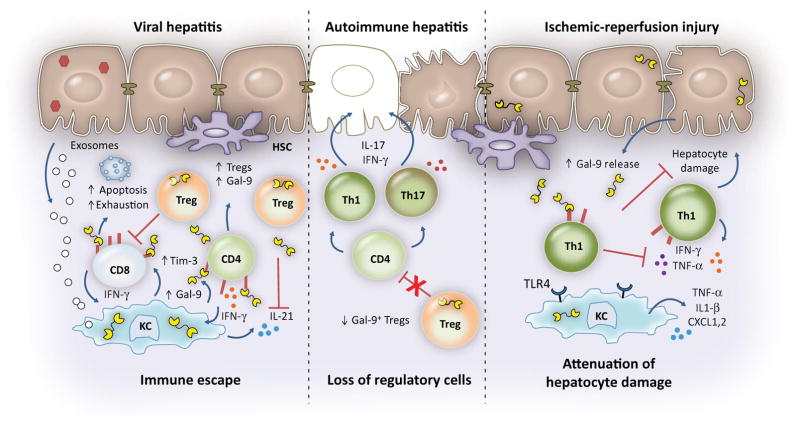FIG. 1.
Paradigm for Gal-9 in the regulation of immune responses during viral hepatitis infection, AIH, and IRI. Exosomes released from HCV-infected hepatocytes and IFN-γ secreted by the hepatic infiltration of T, NK, and NKT cells induce Gal-9 expression in KCs. Gal-9 binding to Tim-3 induces apoptosis of CD8pos T cells, drives the expansion of Tregs, and suppresses proinflammatory cytokine production, leading to immune escape. Gal-9 expands Tregs (including those that express Gal-9) and leads to contraction of effector CD4+ and CD8+ T cells, including the virus-specific population. Whereas acute, resolving HCV is characterized by strong Th1/Th17 responses and increased levels of IL-21-producing CD4+ T cells and circulating plasma levels of IL-21, persistent infection is associated with increased hepatic and plasma levels of Gal-9; in turn, Gal-9 suppresses IL-21 production, compromising HCV-specific cytotoxic T lymphocyte function by up-regulating exhaustion molecules and becoming more susceptible to apoptosis. Knockdown of Gal-9 in Tregs can rescue IL-21 production by CD4+ T cells. To date, the results for HBV infection (although not as complete) appear similar to those for HCV infection. On the other hand, in AIH, Gal-9pos Tregs exert control over disease activity, and loss of this population leads to uncontrolled effector proinflammatory IFN-γ and IL-17-producing cells that are the main orchestrators of liver damage in AIH and that correlate with disease severity. For the significant proportion of patients with AILD who fail to respond to conventional treatments, Gal-9/Treg-based immunotherapy may represent a novel approach. In the setting of liver IRI, activation of Th1 cells and of macrophages and neutrophil recruitment occur early. Macrophages elaborate inflammatory cytokines and chemokines and up-regulate TLR4 expression. Gal-9, predominantly released from injured hepatocytes, acts as a cytoprotective alarmin. Binding of Gal-9 to Tim-3 on T cells decreases proinflammatory cytokine production, chemokine responses, and hepatocyte damage; blockade of TIM-3 promotes Th1 responses and exacerbates IRI-triggered liver injury but only in the setting of intact TLR4 signaling.(15,16,18,22,27–30) Abbreviations: CXCL, chemokine (C-X-C motif) ligand; HSC, hepatic stellate cell.

